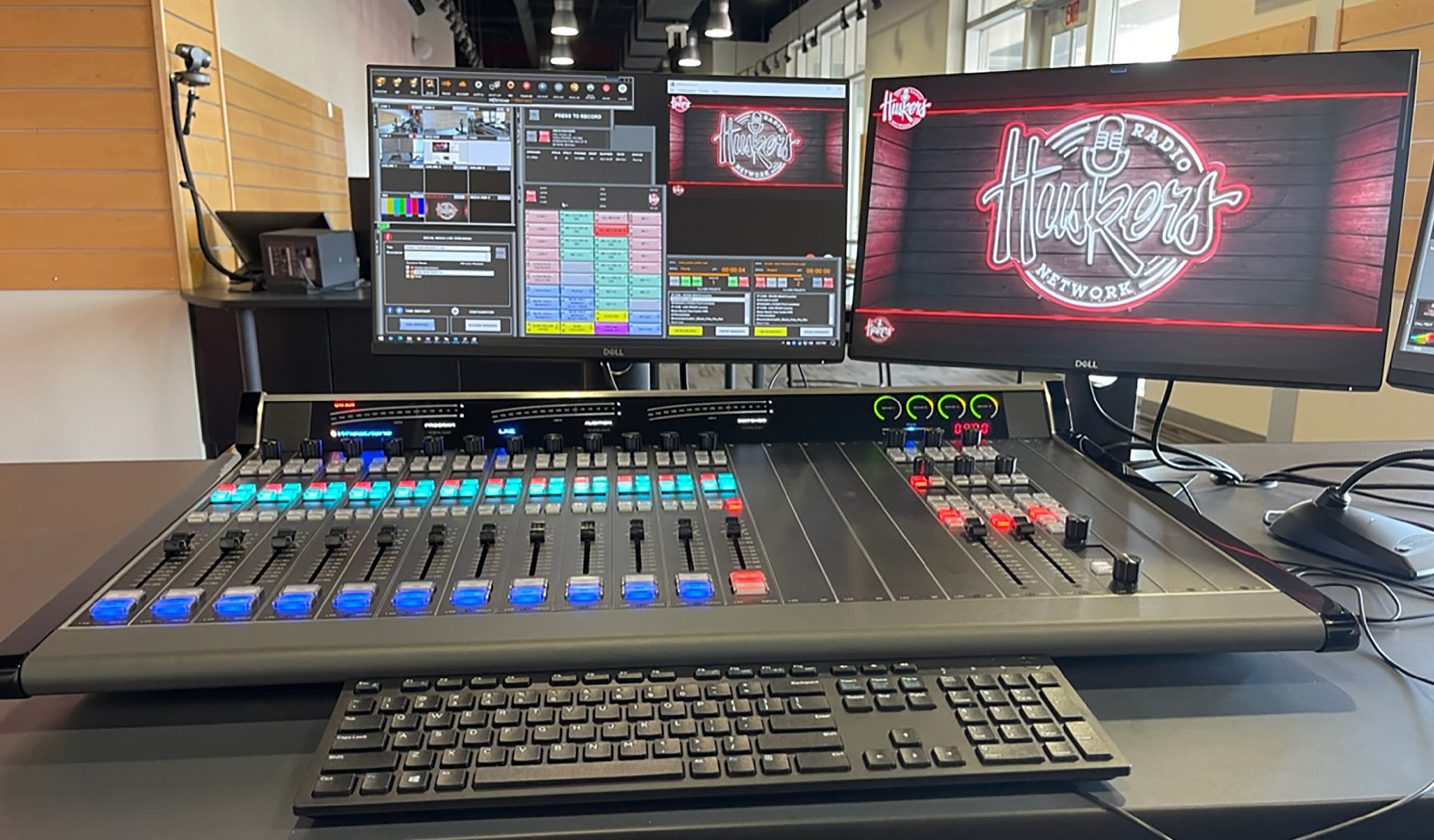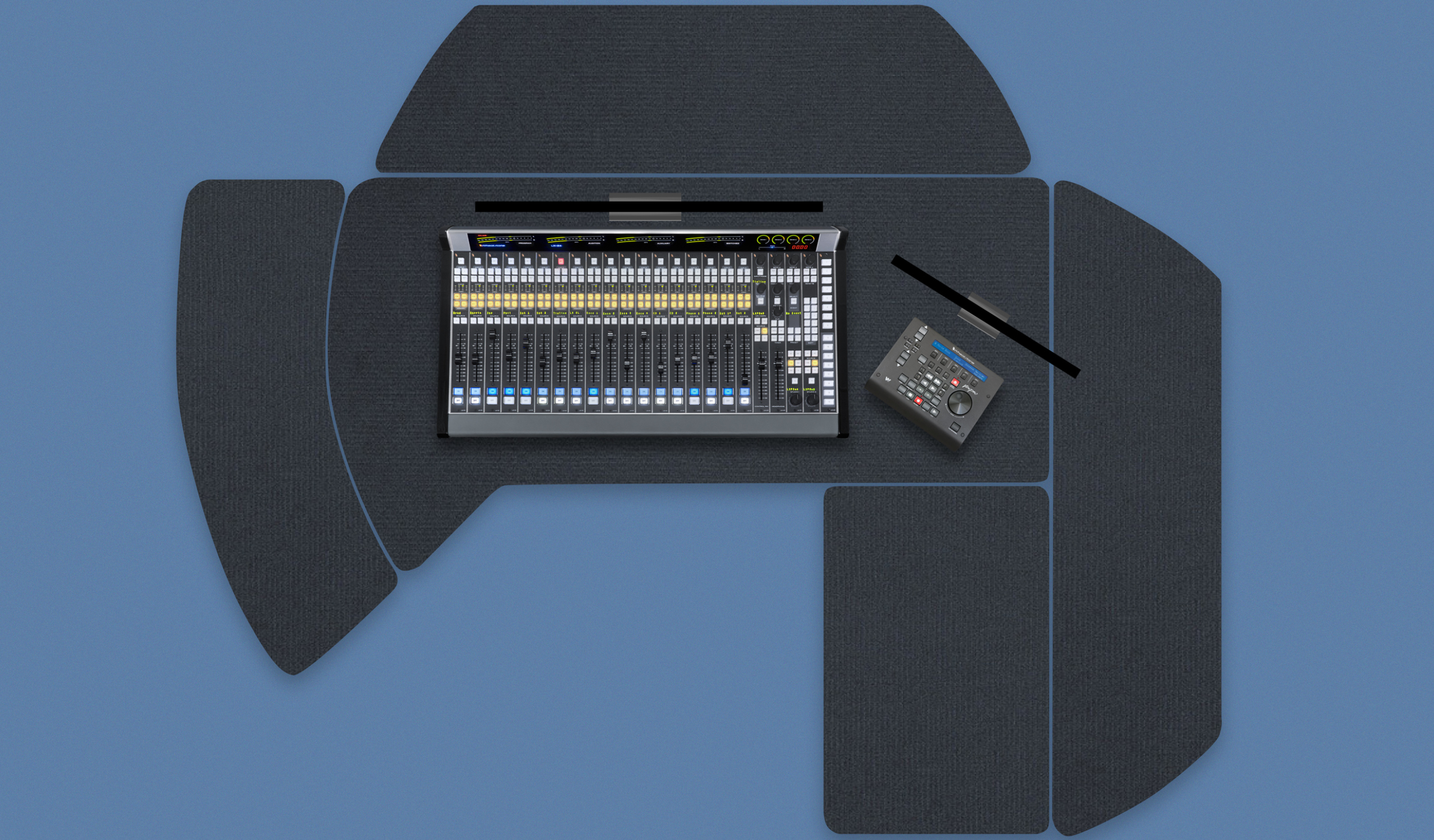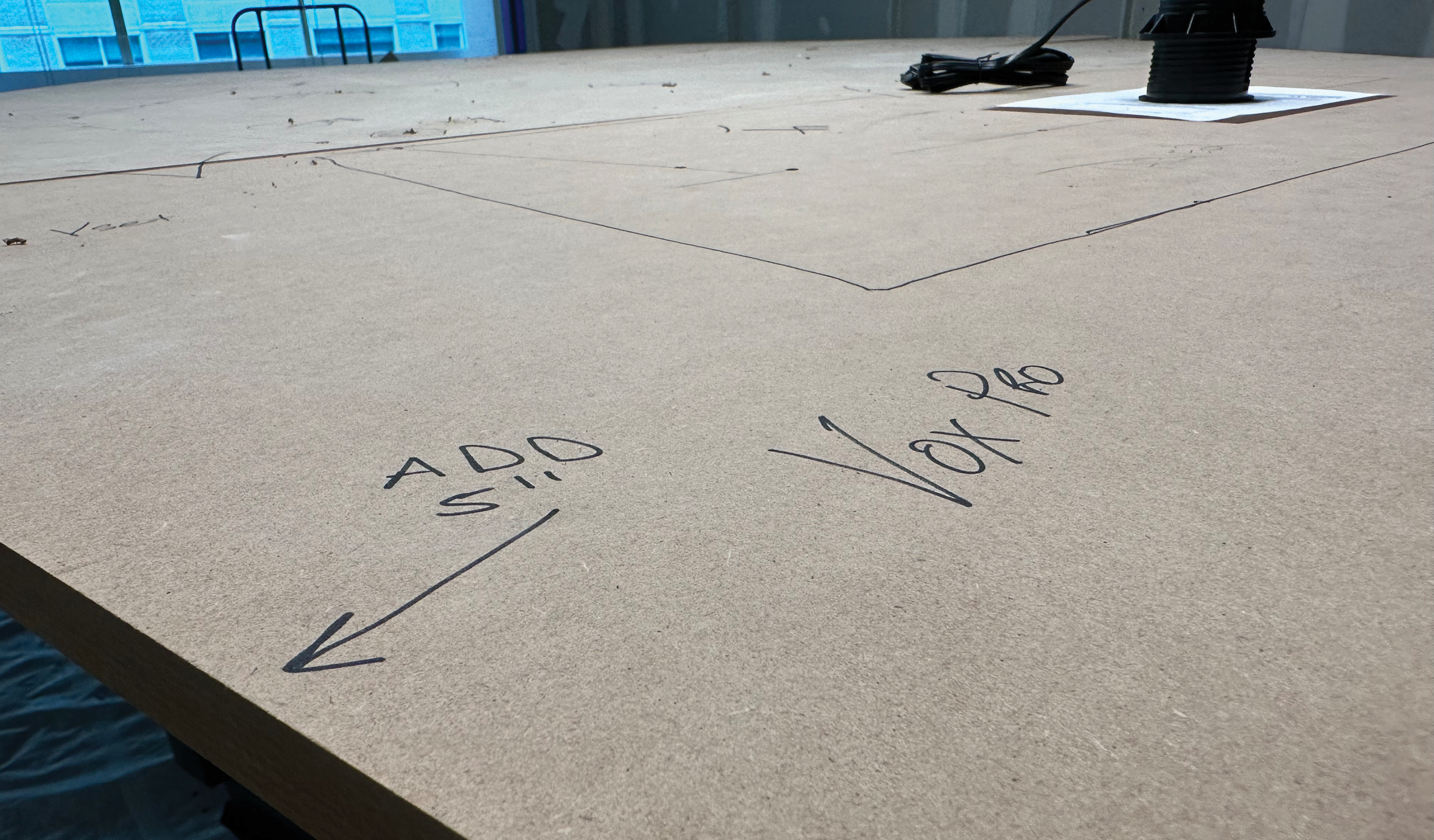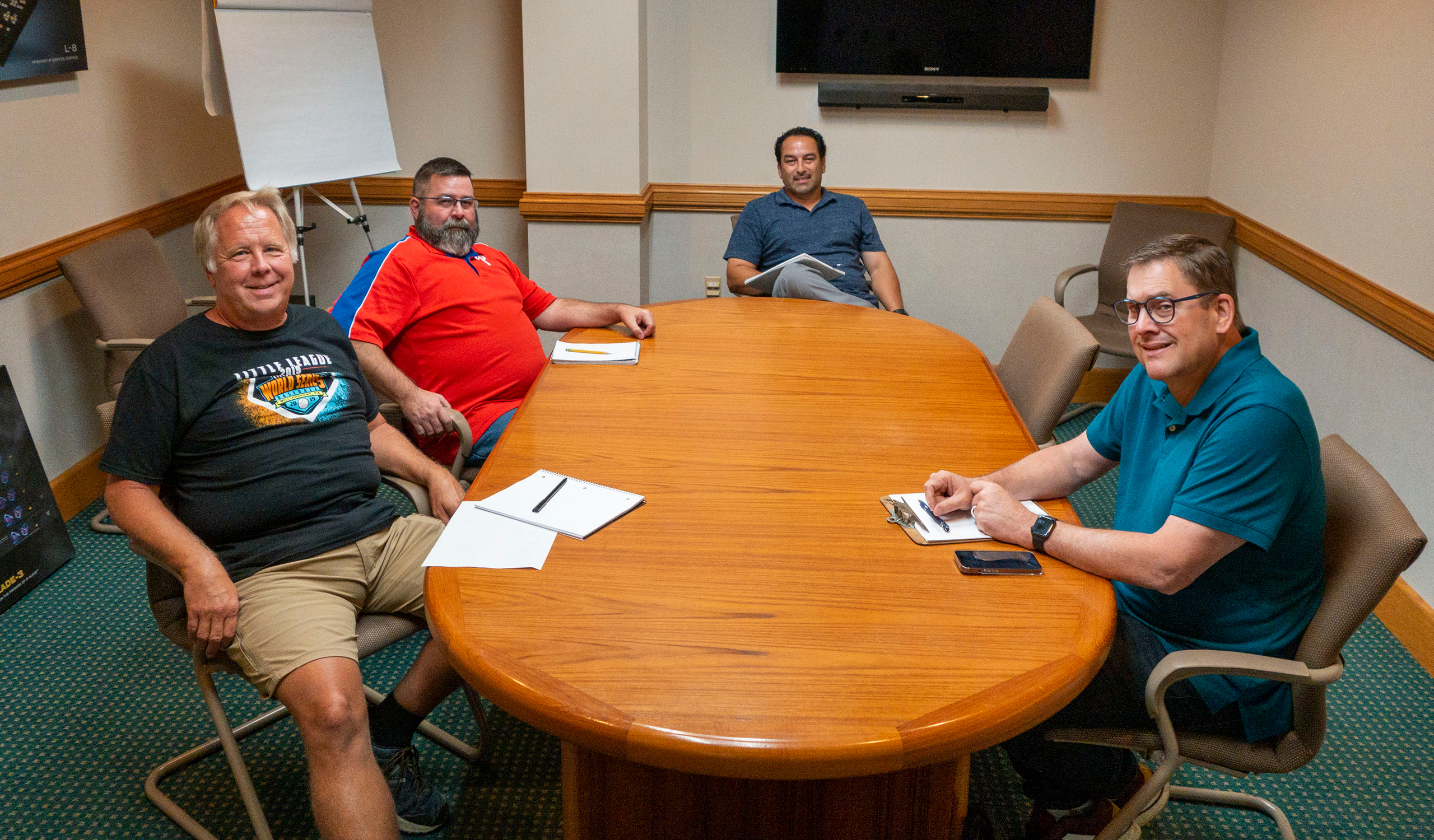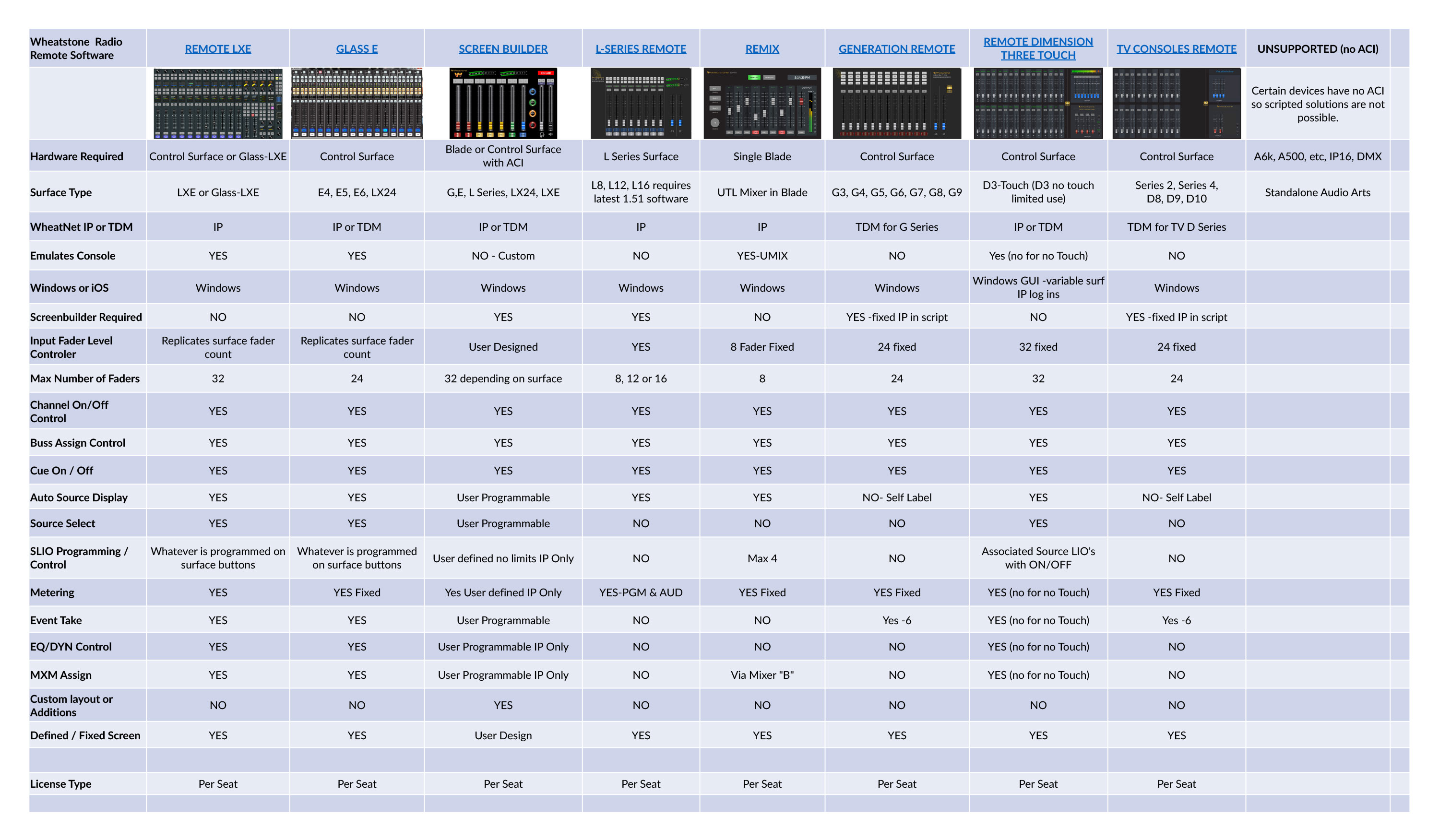WHEAT:NEWS October 2022 Volume 13, Number 10
GO BIG RED
Nothing says “take me out to the ballgame” like a road kit that has all the essentials to set up and broadcast live from the field, minus the onsite engineer and producer. In the case of the Huskers Radio Network, a statewide sports network run by the University of Nebraska, sportscasters take little more than a mic and codec to the field and leave all the production to the home WheatNet-IP audio networked studios in Lincoln, Nebraska.
Setup in the field is simple: “Plug in Ethernet from the venue. Plug in headsets. Mount the antennas for the sideline reporter wireless. Power the kit up and the Huskers Broadcast Center takes over from there via Tieline CCC (Cloud Codec Controller) and VPN connectivity,” explained Huskers Radio Network Director of Broadcast Operations Mike Elliott.
At home, Huskers Radio Network has five live event pods consisting of production tools and LXE console surfaces that ingest audio as well as video from the field. The network distributes sportscasts to more than 50 radio affiliate stations in the state and thousands of listeners through Huskers.com or its streaming app.
All field mics for the play-by-play sportscaster, the color announcer, and the sideline reporters are individually returned to a live event pod, each assigned to a fader on the LXE console surface where operators can automate a mix-minus, change levels, or mix with, say, nat sound, which is also fed to the home studio from the remote venue. The WheatNet-IP audio networked facility is home to one of the largest console surfaces made by Wheatstone, a 32-channel LXE console surface. “Every remote game-site talent − play by play, color, stats, even the sideline reporter − appear on individual ‘pots’ on the Huskers Broadcast Center pod assigned to that game,” explained Elliott.
The Huskers Radio Network can have four simultaneous live Huskers games and eight live internet streams going at once.
The setup is a radio version of the REMI TV remote integration model of operation often used in TV sportscasting. Rather than add the expense of sending producers and engineers to remote venues with the talent, content is captured on the field and remoted into the main studio where all production is done. Not having to ship off a console to a venue every weekend saves on hassle as well as engineering. And because the LXE console surface is a fixed part of the live event pod, the network is able to preserve that tight integration between game play coming in and distribution to affiliates going out.
The stadium Ethernet is typically used as the primary connection between venue and home studio, although the Huskers Radio Network also uses MaxxKonnect cellphone connectivity as a failover link between the home studio and the field.
The University of Nebraska went live from its all-Wheat Broadcast Operations Center in June of 2021, starting the 2021/22 sports season as the first major U.S. college to bring college sports in-house.
The above an excerpt of an article that originally ran in Radio World and is reprinted with permission.
COMMON STUDIO “GOTCHAS”
Workers were nearing completion of a 47-floor skyscraper in Spain when someone noticed that there were no elevators to the top. It turns out that the builders added 27 floors as an afterthought and forgot to include elevators past the 20th floor! An epic project fail, definitely. But even everyday “gotchas” can add up. Here are common studio mistakes to avoid, according to Inrush partners Mike Dorris and Brian Sapp, who have been bitten by the gotcha bug more than once as system integrators for some fairly complex studio projects (including Wheatstone’s largest contract to date involving more than 245 studios in 32 U.S. markets, the majority deliverable in a few months).
The right furniture can make a difference in studio layout, cabling, and even equipment heat load. Shown is Wheatstone’s Quickline modular furniture made specifically for broadcast studios.
5. Dodge furniture failure. “It is the one thing that no one really thinks about, but it totally makes a difference in how the room looks, how it’s wired, and whether you can line up the electric and data cables properly,” said Dorris. “Furniture even makes a difference in terms of studio equipment heat load – whether there’s proper ventilation, for example,” agreed Sapp. Stick to industry standard-bearers if you can or at the least, work with a furniture maker that will give you detailed drawings of the cabinetry and conduits you’ll need. “Furniture is often forgotten but very noticeable when you screw it up,” commented Dorris.
- 6. Do this before routing out holes and pulling cable: get everyone’s input. Dorris and Sapp suggest setting up a temporary countertop during initial studio fittings to allow for a virtually unlimited number of changes by talent, integrator, and architect in real-time until the most ideal layout is achieved. “The biggest gotchas come from the staff and if you’re lucky, you’ll be able to fix it in time,” commented Dorris. “If you don’t know, you can’t fix it. And even if you know and it’s too late, you can’t fix it,” agreed Sapp.
- 7. Assume nothing. Question everything. What’s the voiceover workload? How many and how often are live shows broadcast? How many mics and what type per studio? Maximum budget? Any station acquisitions on the horizon? The answers to these and other questions will feed into the pre-documentation, which will then feed into the equipment list that determines how much cable between rooms, how many racks you need in the TOC, what the UPS load needs to be, and all those details that make up the scope of the project. “What happens is all of that starts driving what you purchase and what you need to do and soon, the two refine each other so that you can catch a lot of things on paper first before they become real issues,” said Dorris.
DISASTER RECOVERY CHECKLIST
We know personally that while natural disasters like Hurricane Ian and Hurricane Fiona are inevitable, so is disaster recovery. As many of you will recall, Wheatstone’s factory is up the coast from Florida in New Bern, North Carolina, where we have had our share of run-ins with hurricanes. In 2018, Hurricane Florence spared our factory but left much of our small waterfront town in ruins. Wheatstone support is stopping at nothing to help broadcasters affected by Hurricanes Ian and Fiona as they begin the long process of recovery. Here’s a quick checklist that our support engineers put together to hasten the disaster recovery process, which we hope will be useful to all our customers.
If you can spare an I/O Blade from the studio, move it to the transmitter site. A Blade at the transmitter site can be especially useful as a final workaround in an emergency because it has silence detection, flexible GPI logic and salvo programming. In our article Blading Up for A Disaster, we told you about a Blade at one transmitter site that had automatically switched over to a backup STL after lightning hit. The engineer happened to be on vacation at the time and he didn’t know for days after his return that the failover even took place. His only clue was the missing HD radio song identifier, which the backup STL didn’t carry.
Network regional locations together. If you already have AoIP networking at most of your studio locations and those facilities connect to their respective transmitter sites via AoIP, interconnecting it all together through commercial IP, fiber, or microwave links is the next obvious step. Should one studio or transmitter get hit by disaster, you can continue emergency updates from any other studio location and/or switch to other transmitters in your interconnected network. We also suggest establishing remote access to the studio by key employees and technical partners as an emergency backup, if you haven’t done so already. There are now many affordable remote apps available for this purpose (ask us about ReMIX).
Back up your studio network crosspoints and settings on a regular basis and put that data on an offsite server as a quick way to restore operation in the event of an emergency. This topped our Disaster Checklist for 2020, but today, you can take this one step further by backing up your entire studio on a server or several servers in different locations. We introduced our Layers Server Software suite earlier this year that essentially puts a complete backup WheatNet-IP studio on a redundant server. Included are backend mixing for a virtual or fixed console, local or remote, and audio processing with RDS and MPX out to the transmitter as well as streaming provisioning, metadata support and audio processing.
Finally, have a backup audio player at the transmitter site so that if all else fails at the studio, you will be able to broadcast an emergency audio loop from the transmitter site. This can be a regular recorder rigged to turn on in an emergency (which can be triggered by silence detection via a Blade), or it could be a clip player in a Blade. Note: not all Blades have a clip player so if you’re repurposing an I/O Blade from the studio to the transmitter site, pick an I/O Blade with optional clip player installed.
AROUND THE WORLD AND BACK IN 4:38
Here’s a quick tour of Wheatstone studios around the world that we did a while back. Enjoy!
IPQ&A
Q: I’ve been hearing about scripting as a way to add on virtual interfaces and other functions to my WheatNet-IP facility. What’s that about?
A: Scripting your own routines into the WheatNet-IP audio network can be useful for creating specialized interfaces and workflows, which could be anything from producer control panels and virtual news desks to an access panel for routing programming to transmitter sites. We even heard of an engineer who scripted the morning jock’s alarm clock so he would arrive on time for his show! Our Screenbuilder, LXE and GSX consoles, talent stations, Sideboards, GP-8/16 and scripted button panels all have scripting capabilities. We suggest starting with our Scripting Wizard, which allows you to assign commonly used functions to screens, button panels and certain consoles without having to invest in a steep learning curve. You might assign an input to any number of pre-defined actions, for example. If the function is not predefined by the Scripting Wizard, you can create your own using our script developer. The script developer includes an editor, a source-level debugger, and a compiler so you can write, debug, test and implement routing, logic and control routines. This can be especially powerful when combined with the utility mixers and logic in our I/O Blades to automate more complicated routines. To get more familiar with scripting, we encourage you to join our Scripters Forum, where you’ll find starter scripts and other information that you might find useful.
THE A TEAM
Meet the Wheatstone Support Team, shown here during a recent meeting of the minds at the Wheatstone factory in New Bern. From left to right, Steve Walker, Ray Devine, Paul Castro and John Davis. Paul Castro is our most recent addition to the team, and comes to us after years of broadcast engineering experience with Univision and prior to that, with iHeartMedia. Together, these four bring more than 75 years of combined broadcast experience to the table.
NEW YORK, NEW YORK! STOP BY WHEAT BOOTH 1518
We’ll be stepping it up a notch at the NAB Show in New York this month with the introduction of Wheatstone Layers, our new software suite that runs on commodity servers. One or two servers can host mixing instances for all your AoIP consoles, locally or remotely, replacing racks of hardware. Plus, Layers gives you backup mixing, audio processing and stream provisioning in an instant. All controlled from your laptop or tablet. See it and hear it at booth 1518.
Also, be sure to ask us about what’s new in audio processing, virtual consoles, routable codecs, signal metering, AES67/NMOS interoperability, and AoIP in general.
We’ll see you in New York, booth 1518.
The Wheatstone online store is now open! You can purchase demo units, spare cards, subassemblies, modules and other discontinued or out-of-production components for Wheatstone, Audioarts, PR&E and VoxPro products online, or call Wheatstone customer support at 252-638-7000 or contact the Wheatstone technical support team online as usual.
The store is another convenience at wheatstone.com, where you can access product manuals, white papers and tutorials as well as technical and discussion forums such as our AoIP Scripters Forum.
Compare All of Wheatstone's Remote Solutions
 We've got remote solutions for virtually every networkable console we've built in the last 20 years or so. For basic volume, on/off, bus assign, logic, it's as easy as running an app either locally with a good VPN, or back at the studio, using a remote-access app such as Teambuilder to run.
We've got remote solutions for virtually every networkable console we've built in the last 20 years or so. For basic volume, on/off, bus assign, logic, it's as easy as running an app either locally with a good VPN, or back at the studio, using a remote-access app such as Teambuilder to run.
Remote Solutions Video Demonstrations
Jay Tyler recently completed a series of videos demonstrating the various solutions Wheatstone offers for remote broadcasting.
Check out the chart below, and/or click here to learn more on our Remote Solutions web page.
 Making Sense of the Virtual Studio
Making Sense of the Virtual Studio
SMART STRATEGIES AND VIRTUAL TOOLS FOR ADAPTING TO CHANGE
Curious about how the modern studio has evolved in an IP world? Virtualization of the studio is WAY more than tossing a control surface on a touch screen. With today's tools, you can virtualize control over almost ANYTHING you want to do with your audio network. This free e-book illustrates what real-world engineers and radio studios are doing. Pretty amazing stuff.
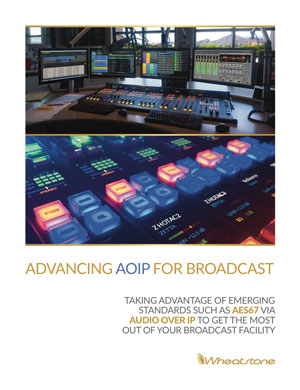 Advancing AOIP for Broadcast
Advancing AOIP for Broadcast
TAKING ADVANTAGE OF EMERGING STANDARDS SUCH AS AES67 VIA AUDIO OVER IP TO GET THE MOST OUT OF YOUR BROADCAST FACILITY
Putting together a new studio? Updating an existing studio? This collection of articles, white papers, and brand new material can help you get the most out of your venture. Best of all, it's FREE to download!
IP Audio for TV Production and Beyond
WHAT YOU NEED TO KNOW ABOUT MANAGING MORE CHANNELS, MORE MIXES, AND MORE REMOTE VENUES
For this FREE e-book download, we've put together this e-book with fresh info and some of the articles that we've authored for our website, white papers, and news that dives into some of the cool stuff you can do with a modern AoIP network like Wheatstone's WheatNet-IP.
Got feedback or questions? Click my name below to send us an e-mail. You can also use the links at the top or bottom of the page to follow us on popular social networking sites and the tabs will take you to our most often visited pages.


